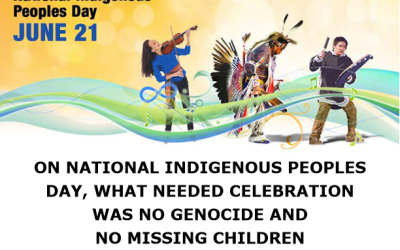Few will argue that federal government Indigenous policy—whether Liberal or Conservative—has failed Canadians. The federal government will be spending some $21-billion on the delivery of Indigenous programs and services this year. Yet the boil water orders will continue. Hopelessness and despair in too many First Nations (FN) communities will continue. It’s obviously time to try something different, something that has never been tried before.
In the spirit of reconciliation, we are proposing a bold, new idea—empowering First Nations families by sharing the land through modernized annuities.
The means for empowering FN families was written into the historic Treaties with the Crown from 1850 onward. FN leaders wanted to ensure the economic autonomy of first people as they shared the prosperity of the new country with the settlers through annuities that increased over time to reflect that prosperity. Only that didn’t happen.
After 1880, the federal government chose to freeze annuities at $4 or $5 per person, depending on the treaty. For a family of five at that time, $20 or $25 was enough to outfit a hunter for the season and buy some comforts for the family. The annuity, along with other income from traditional pursuits, allowed families to maintain a degree of economic autonomy and political independence within their communities. Today, the “economic autonomy” provided by that $20 or $25 annuity won’t even cover lunch for a family at McDonalds.
As with many contentious Indigenous issues in Canada, it takes the courts to step into territory that politicians fear to tread. In December 2018, the Ontario Superior Court of Justice ruled that the $4 annuities paid to the members of the 21 bands signing the 1850 Robinson Huron and Robinson Superior treaties should have been increased in tandem with the growing prosperity of their Treaty lands. That ruling is on hold pending a decision by the Ontario government to appeal. However, even if the current behind-closed-doors settlement discussions bear fruit for the Superior and Huron bands, there is still no apparent mechanism in place to determine how annuities should be valued thereafter.
In the meantime, some of the 290 other Treaty bands are looking for litigation financing so they can launch similar legal challenges. This has the potential of becoming very complicated, messy and costly for band governments, without any assurance that the outcome will be a modernized annuity for FN families consistent with the intent of the Treaties. And there are another 320 bands that have signed modern treaties, none of which include annuities, or have not signed treaties at all.
This has the potential to lead to remarkable disparities in supporting First Nations families across the country. If, for instance, the $4 annuity was to be increased to $4,000, an Anishinaabe family of five from the Robinson Treaty bands would be eligible for $20,000 per year. However, a neighbouring Treaty 3 Anishinaabe family to the west would continue to receive $25 and a Cree family across the Quebec border to the east would receive nothing.
Sharing the land in the spirit of reconciliation should not be based upon which First Nations communities can afford a top legal team. Neither should it hinge on having a sympathetic judge with a good understanding of historic treaty issues. A simpler, fairer solution is to modernize annuities across the board and extend them to all Status First Nations families from coast to coast to coast.
If this sounds like a dramatic change in federal Indigenous policy, it is. Empowering FN families is the opposite of what exists today. The vast bureaucracy of today’s federal Indigenous affairs—the two government departments, two cabinet ministers, and more than thirty other federal departments and agencies also delivering Indigenous programs and services—is structured on tightly micromanaging how Indigenous people live and are governed. And it comes with a hefty price tag.
There is no need to offload the decision-making on Treaty annuities onto the courts. The Indian Act itself is silent on the valuing and distribution of annuities. In fact, it takes only the political will of the Prime Minister and Cabinet to restore the annuity to its intended purpose as a livelihood support, and to extend that benefit to all Status FN families.
In the name of reconciliation, we—the first people and settlers, together—can support a bold and sensible plan to directly empower First Nations families. It’s never been tried before.



